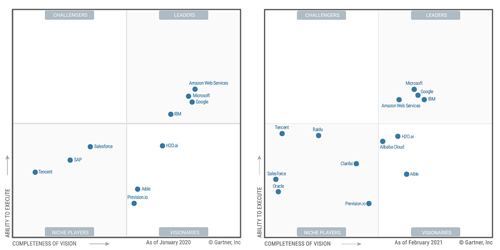News
In Cloud AI Development, AWS Falls Behind Microsoft and Google
Gartner's latest Magic Quadrant report on cloud artificial intelligence (AI) developer services finds former leader Amazon Web Services (AWS) falling behind competitors Microsoft, Google and IBM.
A Magic Quadrant report groups vendors into four categories (Leaders, Challengers, Niche Players and Visionaries) along two axes (Ability to Execute and Completeness of Vision). This year, as in previous years, AWS is firmly in the Leaders section, along with Microsoft Azure, Google Cloud Platform and IBM.
However, while the 2020 report found AWS leading on both the Ability to Execute and Completeness of Vision axes, for 2021 the cloud giant is behind Microsoft and Google on the former axis and trails all three other vendors on the latter axis.
 [Click on image for larger view.] Gartner's "Magic Quadrant" for cloud AI developer services, 2020 (left) versus 2021.
[Click on image for larger view.] Gartner's "Magic Quadrant" for cloud AI developer services, 2020 (left) versus 2021.
Whether that means much on the enterprise front lines is unknown.
Gartner defines cloud AI developer services, or CAIDS, as "cloud-hosted or containerized services/models that allow development teams and business users to leverage artificial intelligence (AI) models via APIs, software development kits (SDKs), or applications without requiring deep data science expertise."
Analysts believe the advent of AI and machine learning (ML) have changed the role of developers in several ways, including introducing the ability to use AI/ML models to classify information, predict trends, assess risks, automate processes and more. Developers can use ML models to add functionality or automate formerly manual processes in order to enhance existing applications or create new categories of applications.
Specifically, the report indicates developers will increasingly incorporate AI/ML models into applications to:
- Build conversational agents
- Extract information from or add metadata to unstructured text or image assets
- Build ML models that suggest next best actions and forecast prospects’ propensity to purchase or automate decision making for business workflows
These efforts will focus on three main functional areas: language, vision and automated machine learning (autoML).
"The language services include natural language understanding (NLU), conversational agent frameworks, text analytics, sentiment analysis and other capabilities," the report says. "The vision services include image recognition, video content analysis and optical character recognition (OCR). The autoML services include automated tools that will let developers do data preparation, feature engineering, create models, deploy, monitor and manage models without having to learn data science."
Licensed-for-distribution copies of Magic Quadrant reports are typically provided by vendors who are covered, easily discoverable with a quick Web search. Note that Gartner says its view of the market is focused on future transformational capabilities of the technology to serve users, and is not necessarily focused on today's market.
About the Author
David Ramel is an editor and writer at Converge 360.